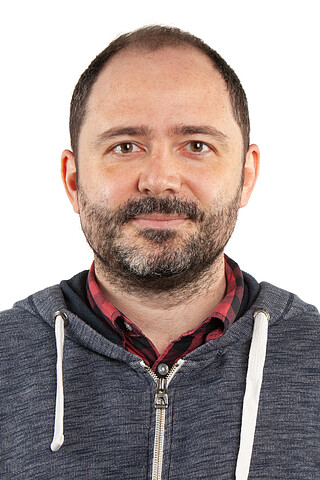- The research done by several students at ESO
- What it’s like to work with ESO’s telescopes and instruments
- How to apply for the ESO Studentship Programme
“One of the high points of being at ESO is seeing the Extremely Large Telescope being built right in front of you!” Aishwarya Girdhar, a PhD student at ESO in Garching, loves witnessing first-hand the development of what will soon be the largest visible/infrared telescope in the world. Key components of the ELT and other telescopes are assembled and tested at ESO’s integration hall in Garching. “Walking by the integration hall every time you can see something new being built and assembled. It is exciting to see what the ELT will bring for us in the future!”
This combination of science and technology makes astronomy uniquely multidisciplinary, with researchers and engineers working side by side to design, build and operate increasingly sophisticated telescopes and instruments. But how can PhD students hone their skills on modern astronomical instrumentation?
Students who are already enrolled in a university PhD programme can spend one or two years at the ESO offices in Germany or Chile, co-supervised by an ESO staff astronomer together with their supervisor at their home university. Students can also do their PhD at ESO via the International Max Planck Research School (IMPRS), of which ESO is a partner. We have talked to five ESO PhD students to learn about their research and what they enjoy the most about their experience at ESO.
From distant galaxies to nearby comets
Aishwarya joined ESO’s PhD programme via the IMPRS. She studies supermassive black holes lurking at the centre of galaxies.
“Some of these black holes are in an active state, which means they are accreting the gas around them and expelling radiation and gas as outflows. These outflows can interact with the gas in the galaxy and cause large-scale disturbances. The aim of my PhD thesis is to understand how these outflows affect star formation in their host galaxies.”
To investigate these so-called active galactic nuclei (AGN), Aishwarya uses various instruments at ESO’s Very Large Telescope (VLT) such as MUSE, which allows her to map the properties and motion of the gas in these galaxies.
Stephen Molyneux, a PhD student at Liverpool John Moores University in the UK, is also trying to unravel the connection between AGN and their host galaxies during his ESO studentship in Garching. “In some galaxies we see radio jets that seem to be driven by the AGN, and they could interact with the gas in the host galaxy. This can lead to galactic outflows and impact on the star formation and gas content of the galaxy, perhaps even removing gas from the galaxy itself.”
Closer to home, in our own galaxy, Sebastián Zúñiga is studying the complex dynamics of multiple stars orbiting each other. “For my ongoing project I observed a quadruple system of stars using the PIONIER instrument on the VLTI at Paranal Observatory,” he says, referring to ESO’s VLT Interferometer, which combines the light gathered by several of the VLT’s telescopes to discern incredibly small details. “With these observations I was looking to resolve different details about the system, which is composed of two binary star pairs orbiting one another.” Sebastián is now back at the University of Valparaíso in Chile after completing his studentship at ESO in Santiago.
Jessica Erkal, a PhD student at University College Dublin, is currently spending one year at ESO in Garching studying how stars form. “My focus is on protostellar jets, which are large columns of material that move away from the star at speeds as high as a few hundred km/s!” she explains. “By examining the size and shape of the jet and how it moves through space we can try to learn how the jet is launched and formed, and if this has an effect on the disk where planets might form.” For her research, Jessica is using data from the X-shooter spectrograph on the VLT. “I’m looking at a sample of almost 200 stars, examining an infrared helium line which tells us if there is material accreting onto the star or moving away from it.”

Comets can also help us understand the formation of planetary systems, including our own Solar System. “Comets provide a unique opportunity to study well preserved material left over from the Solar System formation 4.6 billion years ago,” says Youssef Moulane, who recently obtained his PhD from the University of Liège in Belgium after completing a studentship at ESO in Chile. “I’m interested in the composition and evolution of the comet’s coma, which is a sort of envelope of ice and dust that surrounds the comet.” Youssef has used high resolution spectroscopy with the UVES instrument at the VLT to decipher the chemical makeup of comets. “Comets contain complex organic molecules and may have played a key role in delivering water and organics to the early Earth, contributing to the origin of life.”
Working where the action is
Working under the supervision of ESO astronomers means that chances to visit the observing sites are always around the corner. Youssef was lucky to visit Paranal Observatory, ESO’s flagship facility in northern Chile, home to the VLT. “The most exciting moment for me at ESO was my first visit to Paranal,” he says. “I had seen the VLT and Paranal platform virtually, but I had never been on the site and seen them in real life. It was a great opportunity to be in the control room observing my target in real time.”

Aishwarya concurs, reminiscing of her visits to La Silla Observatory, 500 km south of Paranal: “I got the opportunity to conduct observations on the 3.6-m telescope, the Danish telescope and the New Technology Telescope at La Silla Observatory. I will always remember these experiences.”

Observations are not always done in-situ, though, as Stephen found out. “Recently I was able to see how the observations are done remotely with APEX from here in Garching,” he says, referring to the ESO-operated Atacama Pathfinder Experiment, a 12-metre radio telescope on Cerro Chajnantor in the north of Chile. “We are using the data from this telescope, as well as ALMA, to map the molecular gas in our sample of galaxies. It was really amazing to see how the telescopes in Chile can be controlled from here in Germany!” Here he also mentions ALMA, the Atacama Large Millimeter/submillimeter Array, also located on Cerro Chajnantor, and in which ESO is a partner.
One of the perks of being an ESO student is the possibility of getting involved with instrumentation projects, and Sebastián didn’t let this opportunity pass by. “In November 2018, I participated in the commissioning of NAOMI,” he says, referring to the new adaptive optics module on the VLTI. With one unit mounted on each of the four Auxiliary Telescopes, NAOMI tames the atmospheric turbulence, improving the performance of interferometric observations with instruments such as GRAVITY and PIONEER. This in turn makes it possible to observe fainter targets. “It was a very valuable experience where I spent two weeks at Paranal using and testing NAOMI. I was able to see first-hand the improvements and new opportunities for science that this new module brought with it, while gaining valuable experience in the operations of a front-line observatory.”

Building a vibrant atmosphere
Students are constantly enriching their skills by taking part in various aspects of ESO’s daily life. For instance, ESO organises several international conferences every year in Garching and Santiago, and students can get directly involved. “I was able to be part of the Local Organising Committee for a workshop run online in November,” says Jessica. “It was really fun seeing the behind-the-scenes of everything that goes into organising a workshop!”
Students also lead other scientific activities, such as weekly reviews of colloquia and astronomical news, like Youssef did during his term as student representative in Chile. “It was a really good experience for me. This role gave me the opportunity to interact with staff and get to know more about their research.”
At the end of the day, it’s all about building collaborations with colleagues from all over the world. As Jessica tells us, “since Ireland only recently joined ESO I jumped on the chance to do a studentship here because the lively and collaborative research environment was really exciting!” The studentship is also a unique opportunity for students at Chilean universities because, as Sebastián explains, “you can see more closely the great advances in science that are being achieved in the Atacama desert, giving us valuable experience to develop astronomy and astrophysics in our region.”
Or, as Aishwarya succinctly puts it: “ESO has a beautiful mix of people from all over the world, something I truly cherish and learn from every day!”

How to apply?
By now you are probably wondering how to apply for this exciting research opportunity. You can find all the details in the official studentship webpage. There are two deadlines every year, on May 31 and November 30, and applications must be submitted via ESO’s Recruitment Portal. To do your PhD at ESO via the the International Max Planck Research School on Astrophysics, check their webpage.
For additional perspectives from other ESO students, check out this ESOcast episode, as well as this virtual tour of our facilities, which included a live Q&A with some of our students, postdoctoral fellows, and staff.
Links
Biography Emma Foxell
Emma Foxell is the former ESO blog editor, and a former science communication intern at ESO. Before this, she completed her PhD at the University of Warwick (UK) in the field of exoplanets and transit surveys, focusing on red dwarfs.
Biography Juan Carlos Muñoz Mateos
Juan Carlos Muñoz Mateos is Media Officer at ESO in Garching and editor of the ESO blog. He completed his PhD in astrophysics at Complutense University in Madrid (Spain). Previously he worked for several years at ESO in Chile, combining his research on galaxy evolution with duties at Paranal Observatory.



